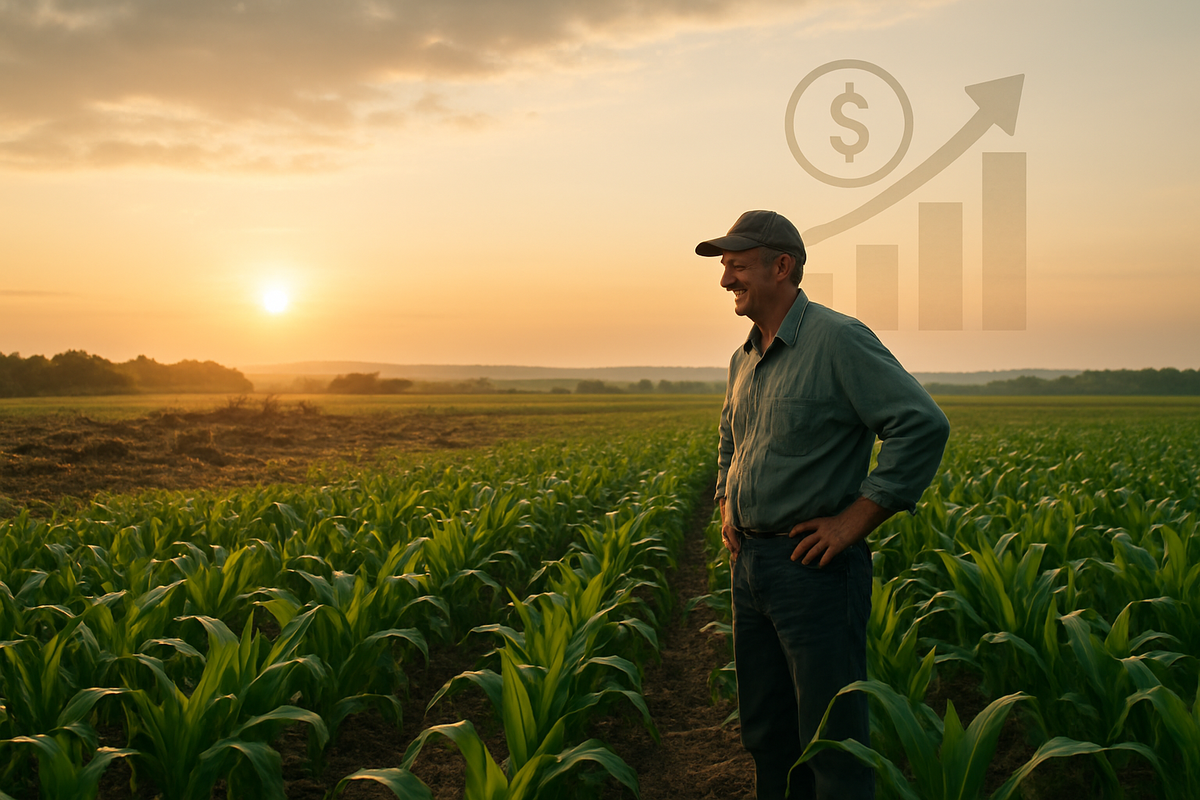
The United States Department of Agriculture (USDA) has unveiled the comprehensive details of the second stage of its Supplemental Disaster Relief Program (SDRP), injecting a crucial $16 billion into the nation's agricultural sector. Announced on Monday, November 17, 2025, this significant financial package is designed to provide much-needed relief to farmers and ranchers grappling with substantial losses incurred during the 2023 and 2024 calendar years due to an array of natural disasters. This timely intervention aims to stabilize farm incomes, bolster the financial health of agricultural operations, and ensure the continued viability of America's food production capabilities heading into the 2026 crop cycle.
This latest tranche of aid, part of a larger $30 billion disaster relief package authorized by the American Relief Act of 2025, underscores the government's commitment to safeguarding a vital industry facing increasing climate volatility. For financial markets, the influx of capital into the agricultural economy is a critical development, potentially influencing commodity prices, the performance of agribusinesses, and the overall economic stability of rural communities. The focused approach on previously uncovered "shallow losses" also marks a notable expansion in the scope of federal disaster assistance, signaling a proactive stance by the USDA to address a broader spectrum of agricultural challenges.
Unpacking the $16 Billion Relief Package: A Deep Dive into USDA's Strategic Support
The $16 billion in disaster assistance is a multifaceted program, with SDRP Stage Two at its core. This phase specifically targets "shallow losses"—a category of non-indemnified, uncovered, and quality losses that have historically fallen outside the scope of traditional crop insurance or the Noninsured Crop Disaster Assistance Program (NAP). This innovative inclusion is a game-changer for many producers who have faced significant financial setbacks from losses that were previously uncompensated. Eligible events span a wide range of natural calamities in 2023 and 2024, including wildfires, hurricanes, floods, excessive heat, tornadoes, winter storms, freeze events, smoke exposure, excessive moisture, and qualifying droughts.
Beyond SDRP Stage Two, the USDA has also opened enrollment for two complementary programs. The Milk Loss Program offers up to $1.65 million to dairy operations (OTCMKTS: DCOW) that were forced to dump milk or remove it from the commercial market due to qualifying natural disaster events in 2023 and/or 2024. Concurrently, the On-Farm Stored Commodity Loss Program provides up to $5 million for producers who lost eligible harvested commodities stored in on-farm structures due to similar natural disasters in the same period. These targeted programs demonstrate a granular understanding of the diverse challenges faced by different segments of the agricultural industry.
The timeline for this critical aid distribution is swift and strategic. While the announcement for SDRP Stage Two was made on November 17, 2025, applications are set to open just a week later, on November 24, 2025. Producers will have until April 30, 2026, to apply for both Stage One (which has already distributed over $5.7 billion to 381,000 producers) and Stage Two assistance. The Milk Loss Program and On-Farm Stored Commodity Loss Program also begin their application period on November 24, 2025, but with an earlier closing date of January 23, 2026, emphasizing the urgency for these specific claims. This expedited process, lauded by USDA Deputy Secretary Stephen A. Vaden, is a deliberate effort to get funds into farmers' hands quickly, contrasting with the often-delayed relief efforts of previous administrations.
The primary purpose of this aid is to inject essential cash flow into the agricultural sector, providing a critical buffer as farmers plan for the 2026 crop year. This financial stability is deemed a national security priority, ensuring the viability and longevity of U.S. farming and ranching operations. The announcement had an immediate, albeit modest, positive impact on grain futures trading in Chicago, suggesting that markets view this aid as a supportive factor for the agricultural economy. While U.S. net farm income for 2025 is projected to be robust at nearly $180 billion, largely due to strong livestock markets and this government aid, crop receipts from grain sales are anticipated to be lower in many states. This highlights the vital role of disaster assistance in offsetting potential revenue declines and maintaining overall sector health.
Market Movers: Who Wins and Loses from the Agricultural Lifeline?
The infusion of $16 billion into the agricultural sector is set to create distinct winners and potentially indirect beneficiaries within the public markets. Companies that directly serve the farming community are poised for a significant uplift as farmer liquidity and purchasing power improve. Agricultural input suppliers, for instance, are expected to see increased demand for essential products. Corteva Inc. (NYSE: CTVA), a major player in seeds and crop protection, along with fertilizer giants like Nutrien Ltd. (NYSE: NTR), CF Industries Holdings, Inc. (NYSE: CF), and The Mosaic Company (NYSE: MOS), are likely to experience stronger sales volumes for the 2025 and 2026 growing seasons. Farmers, with their finances shored up by disaster aid, will be better positioned to invest in high-quality seeds, fertilizers, and pesticides, directly boosting the revenues and profitability of these companies.
Agricultural lenders also stand to benefit substantially. The disaster assistance provides farmers with the capital to repay existing operating loans and reduce debt, thereby improving their creditworthiness and reducing the risk of loan defaults. This is a significant positive for institutions like Federal Agricultural Mortgage Corporation (Farmer Mac) (NYSE: AGM), a government-sponsored enterprise that provides liquidity to agricultural lenders. Farmer Mac's business relies on the health of agricultural loans, and improved farm finances will enhance their securitization market and overall financial stability. Similarly, publicly traded farmland REITs such as Gladstone Land Corporation (NASDAQ: LAND) and Farmland Partners Inc. (NYSE: FPI), while not direct lenders, depend on financially healthy tenants, ensuring steady rental income and potentially supporting land values.
The impact on farm equipment manufacturers like Deere & Company (NYSE: DE), AGCO Corporation (NYSE: AGCO), and CNH Industrial N.V. (NYSE: CNHI) is likely to be more gradual but ultimately positive. Farmers often defer large capital expenditures during periods of financial stress. With improved cash flow and a more stable outlook, there's a strong likelihood that they will be more inclined to invest in new or replacement machinery, including advanced precision farming technologies, in the medium term of 2025-2026. This could lead to an uptick in equipment sales, though it may not be as immediate as the demand for consumable inputs.
Grain handlers and food processors, including industry titans like Archer-Daniels-Midland Company (NYSE: ADM) and Bunge Global SA (NYSE: BG), may experience a more indirect and complex impact. While a more financially stable farming base could lead to a more consistent supply of raw agricultural commodities, reducing supply chain disruptions, their profitability remains heavily influenced by global commodity prices, trade dynamics, and processing margins. The aid primarily offsets past losses and stabilizes income, rather than directly boosting commodity prices in a way that would unequivocally benefit processors. Their performance will continue to be driven by broader market forces, though a healthier farming sector provides a more robust foundation for their supply chains.
Beyond the Fields: Broader Implications for the Agricultural Ecosystem
This $16 billion disaster aid package transcends immediate financial relief; it represents a critical intervention in the broader agricultural ecosystem, carrying significant implications for industry trends, regulatory frameworks, and long-term food security. The USDA's move to cover "shallow losses" is particularly noteworthy, signaling a governmental recognition of the evolving and often under-addressed vulnerabilities faced by modern farmers. This expansion of aid eligibility could set a new precedent for how federal disaster programs are structured, potentially leading to more comprehensive and flexible support mechanisms in the face of increasingly unpredictable climate events.
The aid package also plays a crucial role in stabilizing an agricultural sector that has been under considerable strain. Beyond natural disasters, farmers have contended with volatile commodity prices, rising input costs, and complex global trade dynamics. By shoring up farm incomes, the USDA is not only providing a safety net but also fostering a more resilient and sustainable agricultural base. This stability is vital for ensuring food security, as financially viable farms are better equipped to maintain production levels and invest in practices that enhance long-term productivity and environmental stewardship. The ripple effects extend to agricultural research and development, where sustained farmer profitability can drive adoption of new technologies and innovations.
Historically, federal disaster aid has been a recurring feature of U.S. agricultural policy, often responding to specific, catastrophic events. However, the American Relief Act of 2025 and this subsequent $16 billion distribution appear to represent a more proactive and integrated approach, acknowledging the systemic nature of climate-related challenges. Compared to past programs, the expedited timeline for fund distribution and the inclusion of "shallow losses" suggest a learning curve and an adaptation of policy to contemporary needs. This could influence future regulatory discussions around agricultural insurance, risk management strategies, and the role of government in supporting a sector deemed a national security priority.
The financial health of U.S. agriculture also has broader macroeconomic implications. A stable farming sector supports rural economies, employment, and the supply chains of numerous industries, from manufacturing to transportation. The consistent flow of agricultural products impacts consumer prices and trade balances. Therefore, this aid package is not merely a subsidy but an investment in the foundational strength of a critical segment of the U.S. economy, potentially mitigating inflationary pressures on food prices and ensuring a reliable domestic food supply.
The Road Ahead: Navigating Opportunities and Challenges
The immediate future for the agricultural sector, bolstered by the USDA's $16 billion aid, appears more stable, but several short-term and long-term possibilities warrant close observation. In the short term, the influx of capital is expected to significantly improve farmer liquidity, enabling them to settle outstanding debts, cover operational costs, and make necessary preparations for the 2026 planting season. This enhanced financial footing could lead to increased purchasing activity for agricultural inputs and potentially a modest uptick in demand for farm equipment as farmers gain confidence to invest in their operations. Investors should watch for quarterly earnings reports from input suppliers and farm equipment manufacturers in late 2025 and early 2026 for signs of this renewed spending.
Looking further ahead, the long-term impact hinges on several factors. The aid provides a crucial bridge, but the underlying challenges of climate volatility, commodity price fluctuations, and rising input costs persist. This assistance could encourage farmers to adopt more resilient farming practices, invest in climate-smart technologies, and diversify their operations, mitigating future disaster risks. However, the effectiveness of the aid will also depend on its ability to foster sustained profitability rather than merely providing temporary relief. Market opportunities may emerge for companies specializing in agricultural technology, data analytics, and sustainable farming solutions, as farmers seek to optimize operations and reduce future vulnerabilities.
Potential strategic pivots or adaptations may be required across the agricultural value chain. Farmers might adjust their crop portfolios or adopt more robust risk management strategies, including enhanced insurance coverage, in light of the expanded understanding of "shallow losses." For agribusinesses, a more stable farming customer base could encourage long-term investment in supply chain infrastructure and innovation. Potential scenarios include a period of sustained recovery and growth in the agricultural sector, or, if underlying challenges remain unaddressed, a continued reliance on governmental support. The aid, therefore, presents both an opportunity for revitalization and a test of the sector's long-term resilience.
One key challenge will be managing expectations regarding future aid. While this package is substantial, it's crucial for the agricultural sector to develop sustainable business models that are less dependent on emergency relief. The aid could, however, pave the way for more robust and permanent federal risk management programs. Investors should monitor commodity price trends, global trade negotiations, and the ongoing dialogue around climate policy, as these will continue to be significant determinants of the agricultural market's trajectory. The effectiveness of this $16 billion lifeline in fostering genuine, long-term stability will be a defining narrative for the coming years.
Final Harvest: Assessing the Lasting Impact of USDA's $16 Billion Aid
The USDA's announcement of the second stage of its Supplemental Disaster Relief Program, distributing $16 billion in aid, marks a pivotal moment for the American agricultural sector. The key takeaway is the government's decisive action to inject substantial capital into an industry facing multifaceted challenges, particularly those stemming from natural disasters in 2023 and 2024. This aid, especially its focus on "shallow losses," represents a significant evolution in federal disaster assistance, aiming to provide a more comprehensive safety net for farmers and ranchers. The expedited application process underscores a commitment to timely relief, crucial for maintaining farmer liquidity and confidence.
Moving forward, the market is poised for a period of adjustment and potential growth within the agricultural value chain. Input suppliers and agricultural lenders are immediate beneficiaries, expected to see improved demand and healthier balance sheets as farmers regain financial footing. Farm equipment manufacturers may experience a delayed but positive impact as capital expenditure confidence returns. While grain handlers and food processors will see indirect benefits through more stable supply chains, their performance will largely remain tied to broader global commodity dynamics. The overall assessment points to a more stable, albeit still challenging, environment for U.S. agriculture in the short to medium term.
The lasting impact of this aid package will be measured not just in immediate financial relief, but in its ability to foster long-term resilience and sustainability within the agricultural sector. It highlights the increasing interdependence between government policy, climate events, and market stability. Investors should closely monitor agricultural commodity prices, the adoption rates of new farming technologies, and the ongoing development of climate-resilient practices within the industry. Furthermore, the political landscape surrounding future farm bills and disaster relief funding will be critical to watch, as these will shape the long-term risk profile and investment opportunities in the agricultural space. This $16 billion lifeline offers a breath of fresh air, but the journey towards a truly resilient and prosperous agricultural future continues.
This content is intended for informational purposes only and is not financial advice





